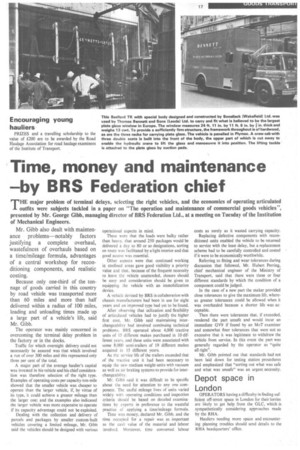Time, money and maintenance —by BRS Federation chief
Page 19

If you've noticed an error in this article please click here to report it so we can fix it.
THE major problem of terminal delays, selecting the right vehicles, and the economics of operating articulated outfits were subjects tackled in a paper on "The operation and maintenance of commercial goods vehicles", presented by Mr. George GM, managing director of BRS Federation Ltd., at a meeting on Tuesday of the Institution of Mechanical Engineers.
Mr. Gibb also dealt with maintenance problems—notably factors justifying a complete overhaul, wastefulness of overhauls based on a time/mileage formula, advantages of a central workshop for reconditioning components, and realistic costing.
Because only one-third of the tonnage of goods carried in this country by road vehicle was transported more than 60 miles and more than half delivered within a radius of 100 miles, loading and unloading times made up a large part of a vehicle's life, said .Mr. Gibb.
The operator was mainly concerned in overcoming the terminal delay problem in the factory or in the docks.
Traffic for which overnight delivery could not necessarily be assured was that which involved a run of over 300 miles and this represented only three per cent of the total.
A major part of the average haulier's capital was invested in his vehicle and his chief consideration was therefore selection of the right type. Examples of operating costs per capacity-ton-mile showed that the smaller vehicle was cheaper to operate than the larger vehicle, if, by virtue of its type, it could achieve a greater mileage than the larger one; and the examples also indicated the larger vehicle was more expensive to operate if its capacity advantage could not be exploited.
Dealing with the collection and delivery of parcels and packages by smaller custom-built vehicles covering a limited mileage, Mr. Gibb said the vehicles should be designed with various operational aspects in mind.
These were that the loads were bulky rather than heavy, that around 250 packages would be delivered a day to 80 or so designations, sorting en route was facilitated by alight interior and that good access was essential.
Other aspects were that continued working in confined areas gave good visibility a priority value and that, because of the frequent necessity to leave the vehicle unattended, closure should be easy and consideration should be given to equipping the vehicle with an immobilization device.
A vehicle devised by BRS in collaboration with chassis manufacturers had been in use for eight years and an improved type had yet to be found.
After observing that utilization and flexibility of articulated vehicles had to justify the higher first cost, Mr. Gibb said maintaining interchangeability had involved continuing technical problems. BRS operated about 4,000 tractive units of 15 different makes purchased in 10 different years. and these units were associated with some 8.000 semi-trailers of 19 different makes acquired in 15 different years.
As the service life of the trailers exceeded that of the tractive unit it had been necessary to equip the new medium weight-units with vacuum as well as air braking systems to provide for interchangeability.
Mr. Gibb said it was difficult to be specific about the need for attention to any one component. The useful mileage lives of units varied widely with operating conditions and inspection criteria should be based on detailed examinadons by experts in preference to the wasteful practice of applying a time/mileage formula.
Time was money, declared Mr. Gibb. and the time occupied for a repair was as important as the cash value of the material and labour involved. Moreover, time consumed labour costs as surely as it wasted carrying capacity.
Replacing defective components with reconditioned units enabled the vehicle to be returned to service with the least delay, but a replacement scheme had to be carefully controlled and costed if it were to be economically worthwhile.
Referring to fitting and wear tolerances during discussion that followed, Mr. Hubert Perring, chief mechanical engineer of the Ministry of Transport, said that there were three or four different standards by which the condition of a component could be judged.
In the case of a new part the maker provided close tolerances to give the maximum life, whereas greater tolerances could be allowed when it was overhauled because a shorter life was acceptable.
. Then there were tolerances that, if exceeded, rendered the part unsafe and would incur an immediate GITR if found by an MoT examiner and somewhat finer tolerances that were not so excessive that it was legitimate to withdraw the vehicle From service. In this event the part was generally regarded by the operator as "quite all right".
Mr. Gibb pointed out that standards had not been laid down for testing station procedures and emphasized that "sorting out what was safe and what was unsafe" was an urgent necessity.
Depot space in London
OPERATORS having a difficulty in finding sufficient off-street space in London for their lorries are likely to get help from the GLC, which is sympathetically considering approaches made by the RHA.
Hauliers needing more space and encountering planning troubles should send details to the RHA headquarters' office.








































































































